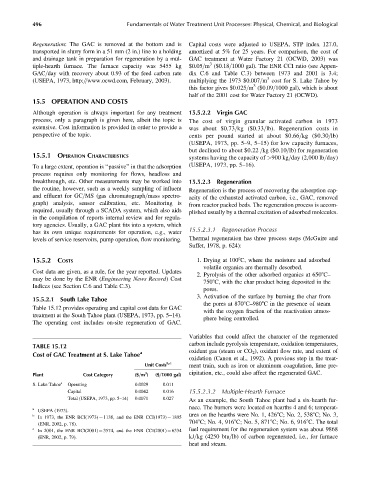Page 541 - Fundamentals of Water Treatment Unit Processes : Physical, Chemical, and Biological
P. 541
496 Fundamentals of Water Treatment Unit Processes: Physical, Chemical, and Biological
Regeneration: The GAC is removed at the bottom and is Capital costs were adjusted to USEPA, STP index 127.0,
transported in slurry form in a 51 mm (2 in.) line to a holding amortized at 5% for 25 years. For comparison, the cost of
and drainage tank in preparation for regeneration by a mul- GAC treatment at Water Factory 21 (OCWD, 2003) was
3
tiple-hearth furnace. The furnace capacity was 5455 kg $0.05=m ($0.18=1000 gal). The ENR CCI ratio (see Appen-
GAC=day with recovery about 0.93 of the feed carbon rate dix C.6 and Table C.3) between 1973 and 2001 is 3.4;
3
(USEPA, 1973, http:==www.ocwd.com, February, 2003). multiplying the 1973 $0.007=m cost for S. Lake Tahoe by
3
this factor gives $0.025=m ($0.09=1000 gal), which is about
half of the 2001 cost for Water Factory 21 (OCWD).
15.5 OPERATION AND COSTS
Although operation is always important for any treatment 15.5.2.2 Virgin GAC
process, only a paragraph is given here, albeit the topic is The cost of virgin granular activated carbon in 1973
extensive. Cost information is provided in order to provide a was about $0.73=kg ($0.33=lb). Regeneration costs in
perspective of the topic. cents per pound started at about $0.66=kg ($0.30=lb)
(USEPA, 1973, pp. 5–9, 5–15) for low capacity furnaces,
but declined to about $0.22 =kg ($0.10=lb) for regeneration
15.5.1 OPERATION CHARACTERISTICS systems having the capacity of >900 kg=day (2,000 lb=day)
To a large extent, operation is ‘‘passive’’ in that the adsorption (USEPA, 1973, pp. 5–16).
process requires only monitoring for flows, headloss and
breakthrough, etc. Other measurements may be worked into 15.5.2.3 Regeneration
the routine, however, such as a weekly sampling of influent Regeneration is the process of recovering the adsorption cap-
and effluent for GC=MS (gas chromatograph=mass spectro- acity of the exhausted activated carbon, i.e., GAC, removed
graph) analysis, sensor calibration, etc. Monitoring is from reactor packed beds. The regeneration process is accom-
required, usually through a SCADA system, which also aids plished usually by a thermal excitation of adsorbed molecules.
in the compilation of reports internal review and for regula-
tory agencies. Usually, a GAC plant fits into a system, which
has its own unique requirements for operation, e.g., water 15.5.2.3.1 Regeneration Process
levels of service reservoirs, pump operation, flow monitoring. Thermal regeneration has three process steps (McGuire and
Suffet, 1978, p. 624):
15.5.2 COSTS 1. Drying at 1008C, where the moisture and adsorbed
volatile organics are thermally desorbed.
Cost data are given, as a rule, for the year reported. Updates
2. Pyrolysis of the other adsorbed organics at 6508C–
may be done by the ENR (Engineering News Record) Cost
7508C, with the char product being deposited in the
Indices (see Section C.6 and Table C.3).
pores.
3. Activation of the surface by burning the char from
15.5.2.1 South Lake Tahoe
the pores at 8708C–9808C in the presence of steam
Table 15.12 provides operating and capital cost data for GAC
with the oxygen fraction of the reactivation atmos-
treatment at the South Tahoe plant (USEPA, 1973, pp. 5–14).
phere being controlled.
The operating cost includes on-site regeneration of GAC.
Variables that could affect the character of the regenerated
carbon include pyrolysis temperature, oxidation temperatures,
TABLE 15.12
oxidant gas (steam or CO 2 ), oxidant flow rate, and extent of
a
Cost of GAC Treatment at S. Lake Tahoe
oxidation (Canon et al., 1992). A previous step in the treat-
Unit Costs b,c ment train, such as iron or aluminum coagulation, lime pre-
3
Plant Cost Category ($=m ) ($=1000 gal) cipitation, etc., could also affect the regenerated GAC.
S. Lake Tahoe a Operating 0.0029 0.011
Capital 0.0042 0.016 15.5.2.3.2 Multiple-Hearth Furnace
Total (USEPA, 1973, pp. 5–14) 0.0071 0.027
As an example, the South Tahoe plant had a six-hearth fur-
nace. The burners were located on hearths 4 and 6; temperat-
a
USEPA (1973).
b ures on the hearths were No. 1, 4268C; No. 2, 5388C; No. 3,
In 1973, the ENR BCI(1973) ¼ 1138, and the ENR CCI(1973) ¼ 1895
7048C; No. 4, 9168C; No. 5, 8718C; No. 6, 9168C. The total
(ENR, 2002, p. 78).
c fuel requirement for the regeneration system was about 9868
In 2001, the ENR BCI(2001) ¼ 3574, and the ENR CCI(2001) ¼ 6334
(ENR, 2002, p. 79). kJ=kg (4250 btu=lb) of carbon regenerated, i.e., for furnace
heat and steam.

